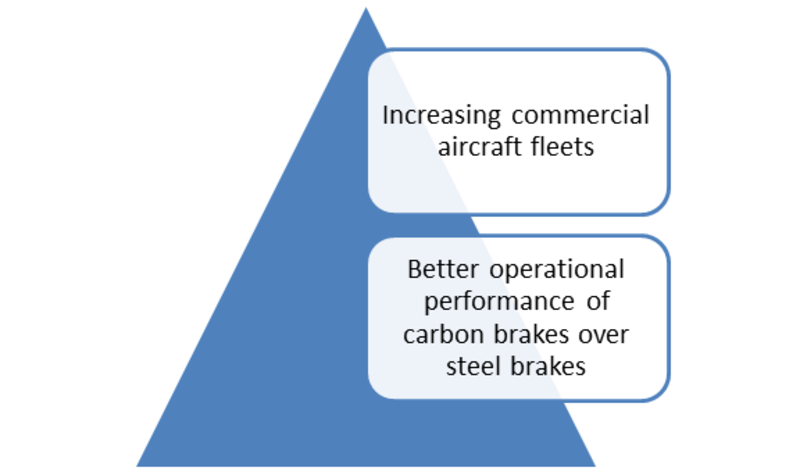Commercial Aircraft Carbon Brakes Market is estimated to witness a CAGR of more than 11% during the forecast period 2018 to 2023
Commercial Aircraft Carbon Brakes Market to have 11% growth during forecast period 2018-2023
Commercial Aircraft Carbon Brakes Market Outlook
commercial aircraft carbon brakes market is estimated to register a CAGR of over 11% from 2018 to 2025.
With the improved operations along with the performance enhancements provided by carbon, brakes have led to increase in the application of carbon brakes in commercial aircraft. The operational advantage of carbon brakes as compared to steel brakes are longer life, cost-effectiveness, high-performance, and lightweight braking system. Furthermore, carbon brakes can withstand the high-performance braking demands of commercial aircraft. Carbon brake material is characterized by high specific heat, high-temperature stability, and high thermal conductivity.
The commercial aircraft carbon market has been segmented on the basis of aircraft type, end-user, material, manufacturing process, and region. Furthermore, the material segment has been sub-segmented by rayon/petroleum pitch and polyacrylonitrile. In these material segments, the polyacrylonitrile segment will have the major market contribution followed by rayon/petroleum pitch during the forecast period. The rise in demand for fuel-efficient aircraft is estimated to be one of the key factor driving the commercial aerospace carbon brakes market during the forecast period.
Aerospace companies and airlines have been looking forward to promoting carbon-reducing measures and energy savings to control and manage greenhouse gas emission that have adverse ecological impacts. Moreover, some airlines companies are investing in the technologies such as energy-efficient as an effective measure to minimize fuel consumption. For example, in Feb. 2018, the UTC Aerospace Systems' designed, “Duracarb” carbon heat sink material brakes, permit for 2,000 landings per overhaul related to 250 landings per overhaul for the present brake system. Its lifecycle is eight times longer, considerably reducing maintenance time and cost. Furthermore, the brakes are capable of handling higher stress and can absorb more heat energy than the existing carbon brakes, which raises the safety margin when stopping heavily-loaded aircraft. Currently, carbon composite brake disks are being broadly used in the landing gear system due to their reduced weight, comparatively low maintenance cost, and enhanced life capabilities. Due to rising number aircraft order from Asia Pacific region, will result into the highest growth rate of this market during the forecast period.
Market Highlights

Key Players
The key players in commercial aircraft carbon brakes market are Crane Aerospace & Electronics (U.S.), Honeywell International Inc. (U.S.), Maritime Goodrich (U.S.), Meggitt (U.K), Parker Hannifin (U.S.), Safran (France), Speedwerks (U.S.), SGL Group (Germany), TAE Aerospace, and UTC Aerospace Systems (U.S.).
Scope of the Report
This study provides an overview of the global commercial aircraft carbon brakes market, tracking four market segments across five geographic regions. The report studies key players, providing a five-year annual trend analysis that highlights market size, volume and share for North America, Europe, Asia Pacific (APAC), Middle East & Africa, and Latin America. The report also provides a forecast, focusing on the market opportunities for the next five years for each region. The scope of the study segments the global commercial aircraft carbon brakes market by its aircraft type, end-user, material, manufacturing process, and region.
By Aircraft type
- Fixed-Wing
- Narrow-body
- Wide-body
- Rotary-wing
By End-User
- OEM
- Aftermarket
By Material
- Polyacrylonitrile (PAN)
- Rayon/Petroleum Pitch
By Manufacturing Process
- Chemical Vapor Infiltration (CVI)
- Liquid Phase Infiltration (LPI)
By Region
- America
- Europe
- Asia Pacific
- Middle East & Africa
- Latin America